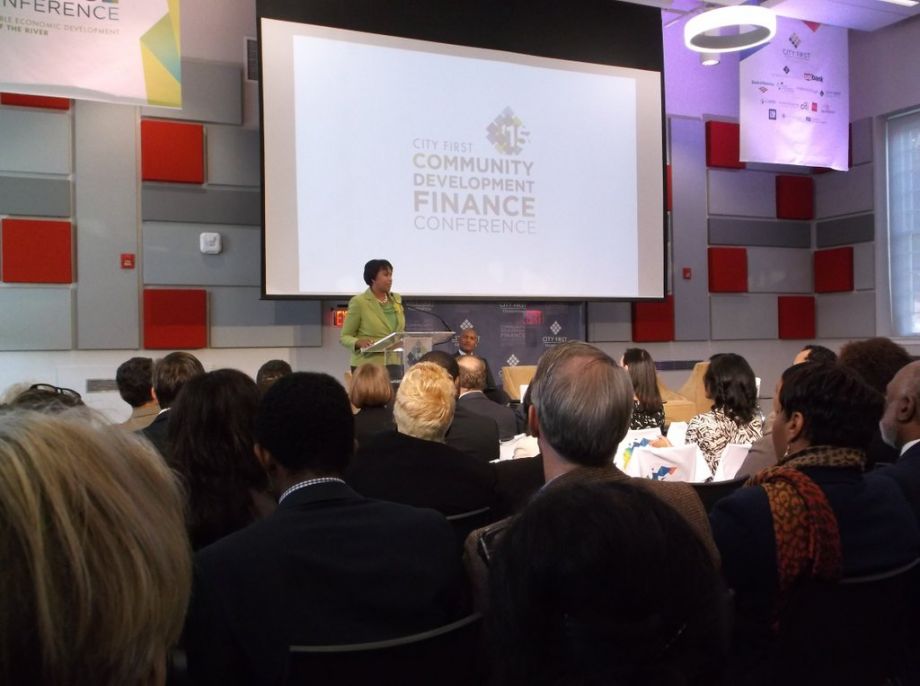Gentrification has been sweeping across Washington, D.C., like the hand of a clock.
From the long wealthy Georgetown neighborhood, it started stretching north and west, to Adams Morgan and Dupont Circle, then farther north to Columbia Heights.
Then the clock hand started spinning around to the historic Shaw neighborhood, beginning with the U Street Corridor (home of Ben’s Chili Bowl and the birthplace of Duke Ellington), then sweeping down south along 14th Street NW and eastward toward the convention center and Chinatown (including construction of the Verizon Center arena). Then farther east into the NE quadrant of the city, along the booming H Street NE corridor.
Now, the clock is ticking on the far eastern and southern areas of the city, separated from the rest by the Anacostia River.
“We knew that the last frontier for development in D.C. is really east of the river. Wards 7 and 8,” says Tabitha Atkins, vice president of community development at City First Bank of DC, which was the first bank in D.C. to earn federal certification as a CDFI (community development financial institution). Some of the bank’s founders were also part of the group that in 1994 helped create the CDFI Fund, an arm of the U.S. Treasury that supports mission-based financial institutions that specialize in serving low-income neighborhoods.
City First Bank is now looking to support neighborhoods east of the river by going beyond just deploying capital. They want to support advocacy for equitable economic development on behalf of those already living and working in these areas. They opened an engagement center last summer in the central, historical Anacostia neighborhood of Ward 8, and convened a conference last fall that led to a white paper, published last month.
A look at the conference Twitter hashtag reveals the concerns of those who attended the conference. “Can’t push homeownership when people are starving without jobs,” tweeted one person.
“How strongly and how universal the jobs theme came out was a surprise,” says Leah Hendey from the Urban Institute, which City First brought in as a key partner for the conference. Hendey co-authored the white paper.
Hendey also presented at the conference, sharing Urban Institute’s data on equitable development (or the lack thereof) in Anacostia. If job growth in Wards 7 and 8 matched job growth in the rest of the city, there would be 6,900 more jobs combined in both wards. Since 1980, average family income in Ward 7 has been stagnant, while family income has declined in Ward 8.
With that in mind, the paper includes key recommendations around jobs, such as creating innovative workforce development and training programs in high schools and vocational schools that connect to specific industries. “Thinking about it years in advance, if there’s transportation or other infrastructure construction and you know that you can target appropriate training to residents in Wards 7 and 8,” Hendey says.
There’s also some lower-hanging fruit that would complement longer-term investments in workforce development.
“If you look at the policies the paper talks about, many are already in place,” Hendey adds, such as D.C.’s first source program that mandates hiring of local residents for city-funded projects. In place for over 30 years, the policy requires that 51 percent of new hires on contracts with D.C. funds of $300,000 to $5 million be city residents. For construction contracts over $5 million, there are specified proportions of hours worked that must be done by residents, depending on the type of worker.
“It’s more a matter of enforcement and making sure projects are meeting those goals,” Hendey adds. Such projects with potential impact east of the river are already in motion, such as the 11th Street Bridge Park, which unveiled its equitable development plan at the City First conference. The day after the conference, D.C. Mayor Muriel Bowser broke ground or cut ribbons on six projects, most of them east of the river.
Enforcing existing local hiring policies can start with the power of new conversations and new relationships. “People that may not have otherwise been in the same room were in the same room that day,” Atkins says of the conference.
City First Bank, with $257 million in assets today, started with a conversation in the basement of Foundry United Methodist Church, in D.C.’s Dupont Circle neighborhood. They hope the paper will start many more. “We want to use the paper as an advocacy tool, not just for the bank itself but for other attendees as they’re meeting with local officials, to at least be a conversation starter to influence policy,” Atkins says.
The Equity Factor is made possible with the support of the Surdna Foundation.

Oscar is Next City's senior economic justice correspondent. He previously served as Next City’s editor from 2018-2019, and was a Next City Equitable Cities Fellow from 2015-2016. Since 2011, Oscar has covered community development finance, community banking, impact investing, economic development, housing and more for media outlets such as Shelterforce, B Magazine, Impact Alpha and Fast Company.
Follow Oscar .(JavaScript must be enabled to view this email address)





_600_350_80_s_c1.jpg)











